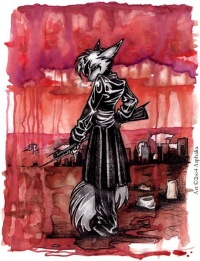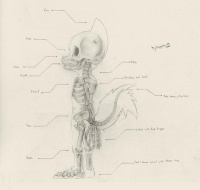Vulpines
The vulpine sentient race is a specific group of anthropomorphic humanoids with many recognizable fox features and characteristics. While not as furry as their animal couterpart, vulpines do differ in fur markings, with red and white being the most popular colors. Their bodies consist of a larger brain capable of more precise and faster execution along with a higher mental capacity. Senses are generally stronger than most species. Agility is their strongest physical trait, but speed and their ability to swim are also strong. Furthermore, the race is regarded as "thin", as their bodies lack a subcutaneous layer common among humans and humanoid species.
Contents
The Vulpine Anatomy
Vulpine creatures tend to represent a fairly equal blend of human and fox-like characteristics. The typical vulpine male stands at about 5'6 to 5'10, weighs between 120-170 lbs, and appears wiry in stature. Vulpine females are noticeably smaller, standing between 4'11 to 5'3, weighing between 70-115 lbs, and also have a wiry stature. Responsible for their thin frames is the lack of a subcutaneous layer many hairless mammals enjoy. This lack of a layer of fat makes them far more susceptible to extreme changes in climate.
At a first glance, these creatures appear to have slightly disproportionate heads, as their skulls house a larger brain capable of more precise and faster execution along with a higher mental capacity. It is roughly 1.1-1.2 times greater than that of a human mind, but the small difference makes them more equipped to solve problems and advance their thinking. Consequently, vulpine history has enjoyed quicker technological advances. To go with their larger brain are large eyes, capable of seeing well under low-light visibility. Vulpine sentient species also report being able to see aural traces on some races and objects, but this has never been totally confirmed. Large, triangular-shaped ears give them four to five times the hearing prowess of a human. These ears are capable of responding to sounds around them (by twisting or moving) or emotions: often when the creature is depressed, the ears will sink downward, and when angry, they may bend back slightly. Their sense of smell is roughly three times as strong as the common human being, but is more able to discern between smells than actually determine if the smell is "good" or "bad". Their mouths display an array of 42 teeth - more canines than molars - and house a tongue that is slightly dulled compared to that of the human tongue. Hair, typically black, grows on their heads, and is different from their fur in texture, density, and length.
The fur of a vulpine sentient is typically short, ranging in length from half an inch to a less than one millimeter. Typically, the length is only 2-3 millimeters, just enough to cover the flesh and protect it from the elements. Legs and arms seem to have the longest fur, while eyelids and fingers seem to have the shortest fur. A vulpine's fur color may vary, even in its own family unit. Colors are determined genetically by different traits carried by both parents. Even recessive traits can mix to form different colors. The typical fur markings seem to be red with white minor, gray and gray with white minor, blue with white minor, and all white.
The vulpine sentient is equipped with two hands of four fingers and one thumb. Their extremities are often bony and veiny in appearance, again due to the lack of a subcutaneous layer. Still, their digits are highly dexterous, capable of complex intricate motion necessary for accomplishing difficult tasks. Feet tend to be long and slim, having enough area to support their upright structures.
Tails are generally anywhere from two to two and one half feet long on the common adult vulpine. Here, the fur grows much longer, having an average length of around six inches. If the fur markings include a minor color, the minor color is typically placed directly on the tip of the tail.
Advantages and Disadvantages of the Vulpine Anatomy
The vulpine form is very sleek and nimble. Consequently, the vulpine body is perfectly equipped for acrobatic feats as well as movements which require high amounts of dexterity. Activities such as climbing, running, and swimming are preferred over actions which require raw strength, something the vulpine form is not designed for.
Vulpine bodies are unable to gain substantial amounts of weight. This is due to their lack of a layer of fat, but structurally, they bodies are not designed to support a large amount of weight. This is a direct consequence of their skeletal structures, which are thinner than that of a healthy human being of the same age.
The vulpine race is susceptible to many diseases, but some are only exclusive to their race. Yellow Plague is a very deadly ailment that affects first the respiratory system, then moves on to the rest of the important body organs. It often appears with very little symptoms at first - normal cold-like ailments appear first, then the presence of a very viscous yellow fluid begins to appear from the throat during coughing. The disease specifically attacks areas in the body that contain oxygen-rich environments, so the lungs are the first to be severely affected, then the throat and nasal areas, then, finally, other areas of the body. It is a very painful disease that would be comparable with a rapidly progressing human AIDS or other deadly diseases. The disease, however, progresses at a more rapid rate, and can be foodborne or airborne if the right conditions are met.
A feature of their anatomy is a proportionally strong heart. This is believed to be a consequence of evolution - if the vulpine did indeed evolve from a common fox, the heart would have to become much more stronger to support a larger frame. Still, a strong pulse is needed to keep their blood circulating, something which dulls with age. This is why most vulpine men and women die from heart ailments than any other disease, and why the common life expectancy for vulpine males is 65-67 and females 69-71.
The Vulpine Body and Vulpine Culture
It is quite common for vulpine males and females to alter their bodies, as their cultures have welcomed such practices throughout the ages. Tattoos and piercings are common and often hold significance, especially for religious purposes. Special circumstances may cause a vulpine to dye its own fur. This is especially true in early Suverian culture, in which vulpine men and women would dye their fur black to mourn the loss of a loved one. Vulpines may also dye their fur for weddings, first communions, and life-changing events.
Tails are generally works of art. They may be dyed different colors, have piercings, or be painted with holy symbols.
The Vulpine Definition of Beauty
Many common traits of beauty from humans are passed down to the vulpine race: symmetry, hygiene, a youthful appearance, and bodies capable of reproducing. However, there exists additional features which tend to further separate the vulpine masses. Very large eyes are something to be desired of in most vulpine societies, with precedence given to crystal blue eyes. Green eyes are rare and are often revered as mystical. A short muzzle combined with large ears is also desirable. Vulpine people prefer long tails, and to have a tail cut off (which some do for job purposes or athletics) is typically looked down upon.
Reproduction and Growth
Young vulpine males and females do not reach sexual maturity capable of reproduction until about thirteen years of age, but any child-rearing below the age of seventeen is a very big social faux pas and is severely frowned upon. Nevertheless, when a vulpine female becomes pregnant, she will wait an average of seven months before the child, called a kit, is delivered. Typically, this produces just one child, as twins and pairings thereafter are relatively rare. When born, the kit is blind and helpless. It is not until the second week that the kit will open its eyes and begin to explore its surroundings. Teeth grow towards the end of the third month, and the kit will normally stand and talk by six months.
As a general rule, birth defects are extremely rare. If a defect does occur, it often is on the tail. In rare instances, a tail-less kit may be born, or a kit with more than one tail may also be born. Generally, this is not received well in vulpine culture, however. Learning disabilities are also very rare, mainly due to the peculiar stability of the vulpine genetic structure.
At around age 40, the vulpine body begins to deteriorate. The strong heart muscles needed to pump blood to their bodies begins to weaken, and the appearance of wrinkles and other signs of old age begin to appear. The reason as to why vulpines tend to age a little faster than human beings is unclear, but all signs seem to point to a general understanding that the vulpine body was not meant to last as long as that of a human. Smaller frames, a heart that appears to weaken with age, and the lack of a subcutaneous layer work against the vulpine race, which contributes to a decreased life expectancy.


